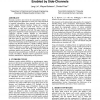Free Online Productivity Tools
i2Speak
i2Symbol
i2OCR
iTex2Img
iWeb2Print
iWeb2Shot
i2Type
iPdf2Split
iPdf2Merge
i2Bopomofo
i2Arabic
i2Style
i2Image
i2PDF
iLatex2Rtf
Sci2ools
113
click to vote
ICCAD
2009
IEEE
2009
IEEE
MOLES: Malicious off-chip leakage enabled by side-channels
Economic incentives have driven the semiconductor industry to separate design from fabrication in recent years. This trend leads to potential vulnerabilities from untrusted circuit foundries to covertly implant malicious hardware Trojans into a genuine design. Hardware Trojans provide back doors for on-chip manipulation, or leak secret information off-chip once the compromised IC is deployed in the field. This paper explores the design space of hardware Trojans and proposes a novel technique, "Malicious Off-chip Leakage Enabled by Side-channels" (MOLES), which employs power side-channels to convey secret information off-chip. An experimental MOLES circuit is designed with fewer than 50 gates and is embedded into an Advanced Encryption Standard (AES) cryptographic circuit in a predictive 45nm CMOS technology model. Engineered by a spread-spectrum technique, the MOLES technique is capable of leaking multi-bit information below the noise power level of the host IC to evade eval...
| Added | 18 Feb 2011 |
| Updated | 18 Feb 2011 |
| Type | Journal |
| Year | 2009 |
| Where | ICCAD |
| Authors | Lang Lin, Wayne Burleson, Christof Paar |
Comments (0)

